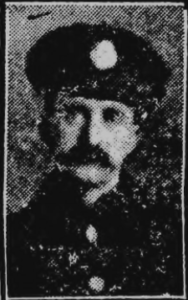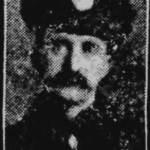
BORN HULL 1881. SON OF ALFRED JONAH DRESSER (1853-1912) & SARAH ISABELLA DRY (1856-1915) DRESSER. SON OF A COOPER. ONE OF TWELVE CHILDREN. WORKED AS A SAWYER FOREMAN. EMPLOYED FOR TWENTY YEARS, BY MESSRS SISSONS BROTHERS, BANKSIDE, HULL.. WELL KNOWN AND A FAVOURITE OF THE ANGLING CLUBS. HUSBAND OF WIFE ELEANOR R WALSH, OF 15 BELMONT STREET, HULL AND 8 LIME TERRACE, HODGSON STREET, HULL (CWGC ADDRESS). HE MARRIED AT HULL IN JANUARY 1915.
HE ENLISTED IN HULL ON 24/11/1914. EX SAPPER, 429, ROYAL ENGINEERS. ARRIVED IN FRANCE, ON 18/09/1915. TRANSFERRED TO THE 1/4TH EAST YORKSHIRE REGIMENT. HE WAS KILLED IN ACTION, ON 25/03/1918, AGED 36. HE IS COMMEMORATED ON THE POZIERES MEMORIAL. HIS NAME IS ALSO LISTED ON ST MARKS STREET MEMORIAL. HIS DEATH WAS REPORTED IN THE HUL DAILY MAIL, ON 03/07/1919.
Spring Offensive – During the winter of 1917–18, the 1/4th East Yorkshires as part of the 50th Division, spent some time in the line, interspersed with training. By mid-March it had been transferred to GHQ Reserve in the Amiens area, 20–25 miles behind the lines. 1/4th East Yorkshires was still one-third under strength, but had been reinforced to 22 officers and 660 other ranks. The German spring offensive opened on 21 March 1918 (the Battle of St Quentin) and the division was urgently called forward to be deployed along the Rear Zone defences or ‘Green Line’. There they attempted to improve the partially-dug trenches before the troops retreating from the German advance passed through them late on 22 March. That evening the 1/4th Green Howards were driven out of the Green Line, leaving 1/4th East Yorkshires in a precarious position with the enemy in their right rear. The attack ceased at nightfall and 150th Brigade ordered the battalion to pull back to Vraignes. Later that night the decision was made to withdraw the whole division west of the Somme during the night, but these orders were late reaching the battalion, which had to fight a rearguard action the following morning as the enemy advanced with motor machine guns through the morning mist, B Company being cut off. The battalion retired through a heavy barrage and the survivors (14 officers and 332 other ranks) scrambled across the bridge at Brie just before it was blown up.
150th Brigade was next attached to 8th Division to defend the Somme Crossings at Éterpigny. The exhausted men were sent cross-country with their Lewis guns, limbers and water carts to join 24th Bde. There was no fighting on this front on 24 March, and the battalion snatched some sleep in an abandoned Casualty Clearing Station, but the enemy were across the river at Épénancourt and 1/4th East Yorkshires and 1/4th Green Howards were detailed to drive them out at 05.00 next morning. The battalions marched through the night to Licourt to prepare for this attack, but it was called off when the enemy broke through near Licourt. 1/4th East Yorkshires launched A Company in a counter-attack carried out ‘with great gallantry’, but it was unsuccessful, and the two battalions fell back 2,000 yards (1,800 m). At 20.30 on 25 March orders arrived to withdraw further to a line of trenches at Ablaincourt. A Company was still missing, and the whole of 150th Bde was so weak that it was formed into a composite battalion under the command of Lt-Col W.T. Wilkinson of 1/4th East Yorkshires.[21][22][68][69]
On the morning of 26 March the Germans renewed their attacks, bringing on the Battle of Rosières. 50th (N) Division was under instructions to fall back if attacked in strength, and orders for 150th Bde to retire arrived at 08.00, coinciding with the attack. But the formation to the right went back more quickly, leaving the flank open; this made the brigade’s retirement difficult, and 1/4th East Yorkshires lost nearly the whole of C Company. Luckily, the enemy were feeling their way forward across difficult country and it was not until 22.00 that they attacked the East Yorkshires in their new positions. The attack was repulsed, but Lt-Col Wilkinson was wounded. The battalion remained in position on 27 March, while the detached A Company joined with some reinforcements to put in a ‘brilliant’ counter-attack. Another attack was driven off in the evening, then at dawn on 28 March 1/4th East Yorkshires was ordered to pull back into reserve. The retirement continued by bounds during the next two days, with long marches. By 30 March the 150th Bde Composite Battalion under Capt C.T.A. Pollock of 1/4th East Yorkshires, operating under 20th (Light) Division, was holding on in a wood on the Moreuil–Demuin road. A charge by the Canadian Cavalry Brigade captured Moreuil Wood, but the enemy still held Demiun. In the evening Pollock organised a counter-attack with support from a battery of field artillery and by some machine guns. Pollock and Captains Barr and Ruthven of 1/4th East Yorkshires led the attack, which cleared the woods at bayonet point, taking 73 German prisoners and re-establishing the line south of the River Luce. The composite battalion repulsed another counter-attack next morning, before falling back to Domart, where the remnants of 50th (N) Division were relieved and the retreat ended. Captain Pollock was killed in this final retirement, and the 1/4th East Lancashire marched out on 1 April with just three officers and 36 other ranks; 30 more who had been separated during the retreat caught up with them in camp.
